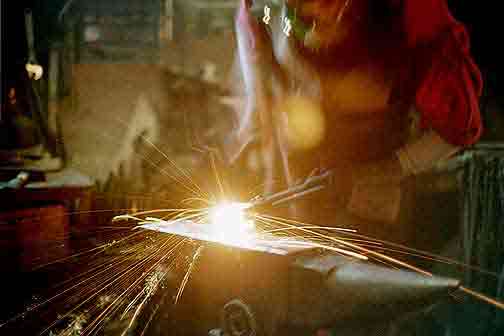"... I am a 14 yr old student who is studying vikings. I am trying to find out what the vikings used in order to weld. I cannot find it in any of our libraries books. I know that the modern blacksmith can use borax. Did the vikings use this or something similar? "
Thats a pretty good question:
Borax is commonly used by * modern * and * north american * blacksmiths. Its what I use in my shop here. There are a couple of different versions available. You can purchase a product called 'Easy Weld', which is borax mixed with iron filings. The wee bits of iron dust make the two pieces you want to join tend to stick together quickly, but also leave the welded surfaces covered in lumps. So this stuff is ok for big structural work (or for a horse shoe) but not any good for finished work (say like pattern welding on a sword).
You can purchase chemically refined (water removed) forge borax. This stuff works great, but its pretty darn expensive (although you don't need very much). At something like $50 a kilo its more than I want to spend.
I use plain old washing borax from the grocery store - like '20 mule team'. This has the water still in the chemical, so it bubbles up a lot when applied to the red hot metal. But its also cheap, at something like $5 for a 2 kg box.
Now - borax is a chemical that only occurs around some specific dry lakes usually found in deserts, where the water evaporates and leaves the powered chemical behind. None of that in Northern Europe (that I know of?).
The tradition in England, and in Denmark (at least) is to use a fine while silica sand. I know smiths still working in both countries that still use sand as a flux when welding. I must tell you that I personally have not ever done this! What I have been told (and it fits the chemistry) is that the metal needs to be hotter before the sand flux is applied (higher melting point for silica) than would be used with borax. This suggests more skill for the smith.
The reason here is that the purpose of the flux in the first place is to seal the surface of the bare metal from the effects of oxygen. The iron oxide, a dark scale, that forms on the metal surface when heated and exposed to oxygen, will not weld. So you would want to carefully watch how much air you blew into the fire, then very quickly pull out and apply the sand flux to seal the surface.
 A classic forge welding image. The bright sparks are actually droplets of hot liquid slag being forced outwards under the hammer stroke.
A classic forge welding image. The bright sparks are actually droplets of hot liquid slag being forced outwards under the hammer stroke.Then when the metal pieces are heated further to the correct temperature (a bright yellow to white) they are quickly moved to the anvil and stuck with the hammer. The series of blows have to overlap, moving from the centre of the pieces towards the edges. This compresses the joint to squirt out the flux between the pieces. Hopefully the now liquid flux also lifts away and washes out any oxides or dirt that may be between the pieces (or you get a failed weld). The trick is to hit hard enough to squirt out the flux and compress the pieces to fuse them, but not so hard as to completely distort the very hot (thus very soft) metal. Oh - and do this all working darn fast - as the metal will cool from 'welding heat' in mere seconds.
Did I mention that your Norse anvil is maybe 10 x 10 cm and maybe 5 kg - or maybe even a rock? Different metals have different welding temperatures too. Makes you understand how difficult is was to produce a pattern welded sword in the Viking Age.
You might find some more information related to Norse and Saxon knives and their construction on the blog (below). I have an article on Viking Age knives I was working up also on line:
http://www.warehamforge.ca/norse-knives/
I would suggest flux for the Viking Age is most likely going to be white silica sand. I do note however that is is just the kind of thing that is pretty hard to state for certain. You would have to pour through chemical details on academic reports on the archaeology for any evidence at all - assuming any one has ever closely examined the question.
Welcome to the world of artifacts and archaeology!




















3 comments:
Could you not assay the ground around Viking forge sites and determine a lot of things, not the least of which would be the spent flux?
Has this been done? Is there any point to it?
I am a professional traditional blacksmith who does a lot of Medieval and Viking Age reenacting. A traditional flux besides fine sand is also ground seashells. The calcium silicate has a lower melting point closer of that to borax. Since the Old Norse(Vikings) were a seafaring/coastal people we can assume they had a ample supply of sea shells.
I always wonder at the seashell content of most natural beaches. If you ever scoop out a handful of wet sand, you see a significant portion of it is actually ground up shell fragments of varying sizes.
Post a Comment